Dynasty Fantasy Football Mailbag: Kyren Williams Here to Stay?
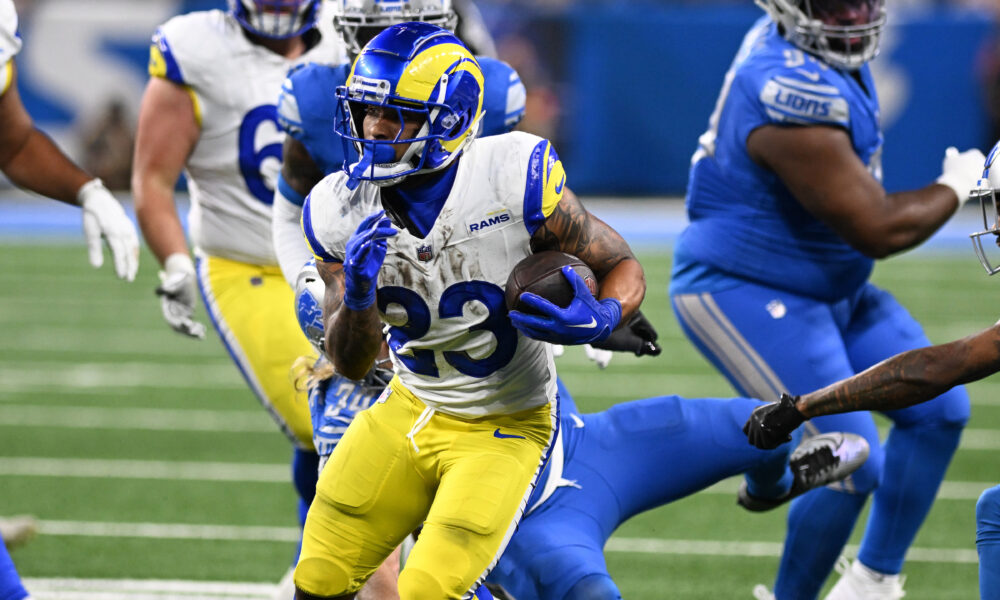
Welcome back to the DLF Mailbag, the preeminent mailbag in all the dynasty fantasy football land. As a reminder, there are multiple ways to pose your burning questions! I’ll be soliciting weekly feedback via X/Twitter (look for a new pinned tweet each Monday), and you can also reach out using our Discord channel, or the old-fashioned way (via our online webform).
The remaining teams have taken their first steps into the NFL playoffs, with another four games incoming this weekend. We’re also now in the midst of the annual coaching firing/hiring season, with changes doubtlessly ready to ripple into the 2024 fantasy campaign. This is all to say that while we’re not winning any seasonal fantasy matchups right now, there is still actionable information to be gleaned.
Let’s get to it!
Sirens for Kyren?
Why is Kyren Williams different than all the other one year wonder types? Zac Stacy, Peyton Hillis, Jay Ajani etc.
— QB (@patwrightQB) January 9, 2024
Obviously I can’t guarantee anything, but there are several data points working in Williams’ favor. First and foremost, he was a league leader in snap percentage at the running back position. Importantly, this did not change after he was placed on Injured Reserve and not playing a down for nearly 1.5 months. Shown below are the snap rates, courtesy of 4for4.com, for Rams running backs both prior to Williams’ injury and to close out the season.
Before:

After:

As can be shown, when healthy Williams was minimally a 70%+ player, with multiple instances above 80%. He also received deferential veteran status in being able to rest in week 18 after the Rams locked up their postseason bid. On the year he played 82% of available snaps when healthy.
Continuing, Williams’ robust snaps reflected his usage. Despite missing five contests and coming in off the bench in one other, he tripled the number of carries of the next closest player, Royce Freeman. In doing so he averaged a healthy 5.0 YPC, with just under 100 yards per game. He also finished fifth on the team in both targets and receptions, and had more than double the number of total touchdowns versus any of his teammates.
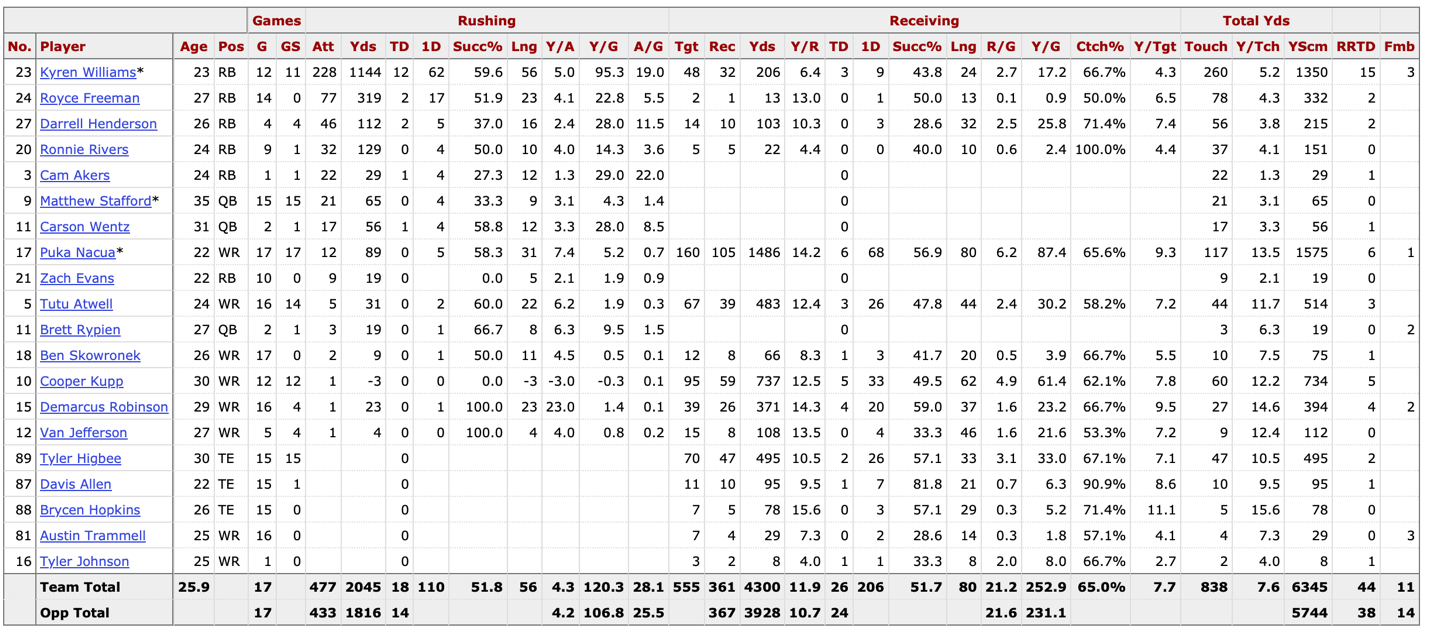
Stats courtesy of Pro Football Reference.
Notably, head coach Sean McVay isn’t shy about making his feelings known about his players. Whether via trade or outright release, he hasn’t been hesitant to rid the team of highly drafted players such as Jared Goff, Cam Akers and Van Jefferson, and in Akers’ case it was likely due in part to the team’s comfort with Williams. He’ll also throw lowly drafted players such as Williams and Puka Nacua into the fire – when it comes to McVay, the most important things seems to be whether or not you make the team better. As such I won’t penalize Williams for his fifth-round draft capital, much as I didn’t double-penalize him at the time for his sub-average measurables, as they clearly helped lead to his draft-day slide.
Combined, these stats and circumstances make an effective case for Williams. But to the actual question – what makes him different than one-hit wonders like Jay Ajayi, Peyton Hillis and Zac Stacy? The answer is I don’t know, other than the fact they’re completely different human beings with little in common other than draft status. I get being nervous about a repeat performance from a lightly drafted player – I’m still stung by a prior investment into the Texans’ Steve Slaton – but his fizzling out certainly didn’t influence his successor in the undrafted Arian Foster!
I could try to sell you on a better collegiate profile, including an earlier breakout against top-tier competition as a differentiator, along with robust dual-threat usage. He didn’t come with the injury concerns like Ajayi, was better in the passing game than Stacy, and showed much more in both college and his first couple of NFL seasons than Hillis. But ultimately you have to decide if you trust what you see. To me, the only real red flag with Williams was his NFL Combine, which appears to be in the rearview mirror – as such I’m still bullish on him moving forward regardless of past predicates.
Rookie Trades!
Hi Eric! What do you think it would take to move up from a mid-first round pick (say 1.05) in rookie drafts to the 1.01 / 1.02 (single QB, 10 teams)? I imagine it could be considerably less expensive to target the 1.02, but am trying to understand the value differential. Thanks!
— CushyCreditBoi (@CushyCreditBoi) January 9, 2024
Let’s start with a baseline assessment using DLF’s Trade Analyzer. This isn’t an exact science, but as noted in last week’s Mailbag there just isn’t enough information with the appropriate pick-by-pick granularity. As the off-season rambles on, I anticipate we’ll be able to provide more of a consensus opinion on these types of queries.
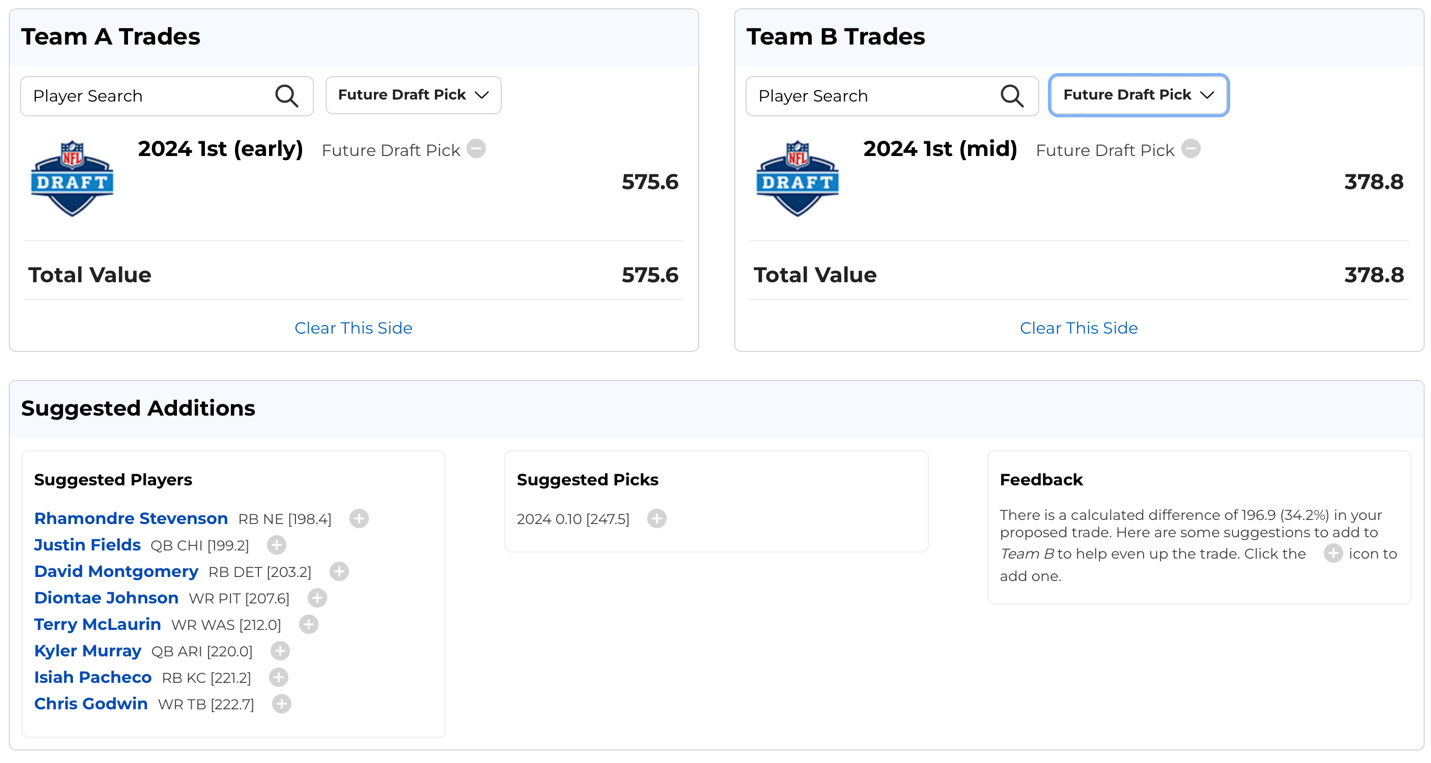
As shown above, there is a 34% difference in valuation between an “early” and “mid” 2024 first-round pick. This is a good starting point, but we can add some nuance here – unfortunately, doing so won’t help the “mid-first” side. First and foremost, the 1.01 is going to be hard to acquire this year given the presence of Ohio State Buckeye receiver Marvin Harrison Jr, and as such I’d likely bump up the value shown above. Secondly, Harrison’s teammates Emeka Egbuka and TreVeyon Henderson opted to stay in college, thereby hollowing out the middle of the first round which seems to lack a consensus after Rome Odunze at 1.03. The value above is probably about right, but it’s nonetheless worth noting the potential depreciation.
Particularly if I earned pick 1.01, it might not surprise you that the players listed as “suggested additions” wouldn’t really move the needle for me. Though there are guys I like, none possess the combination of age, talent and upside I’d be seeking – Isiah Pacheco comes closest, but I’d still want more.
To add some gradation here, I’ve gone through the ADP in an attempt to see where I’d slot Harrison in with the current NFL hierarchy. While it might seem a bit forward, I’d have him right ahead of Dolphins receiver Jaylen Waddle, equivalent to Jets ball carrier Breece Hall. This results in a sizeable shift to the trade valuation.
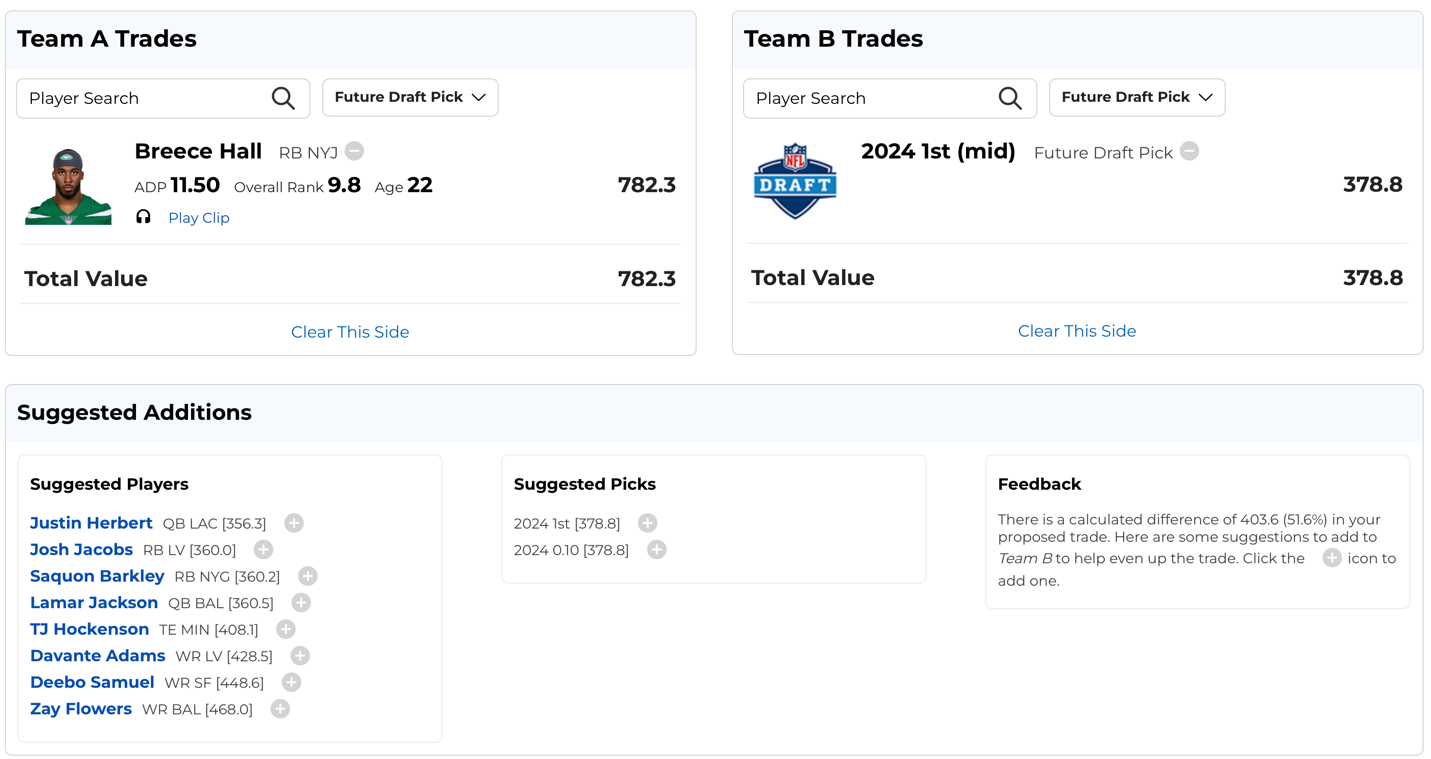
This seems more like it. While again I’d be skewing younger, I’d love a massive upgrade at quarterback (even in a 10-team, 1QB league) with someone like Lamar Jackson. But likelier I’d be gunning for either tight end TJ Hockenson or receiver Zay Flowers. On the surface it appears to be a lot, but the onus is on the buyer as the seller really has no motivation to move off a generational talent in Harrison. The upcharge is warranted.
Doing the same exercise with Malik Nabers, the presumed 1.02, I’d slot him in right around the Devonta Smith range. Nabers isn’t quite as bulletproof as Harrison, but seems likely to be a future NFL top 10-15 pick after putting up big numbers the past two seasons.
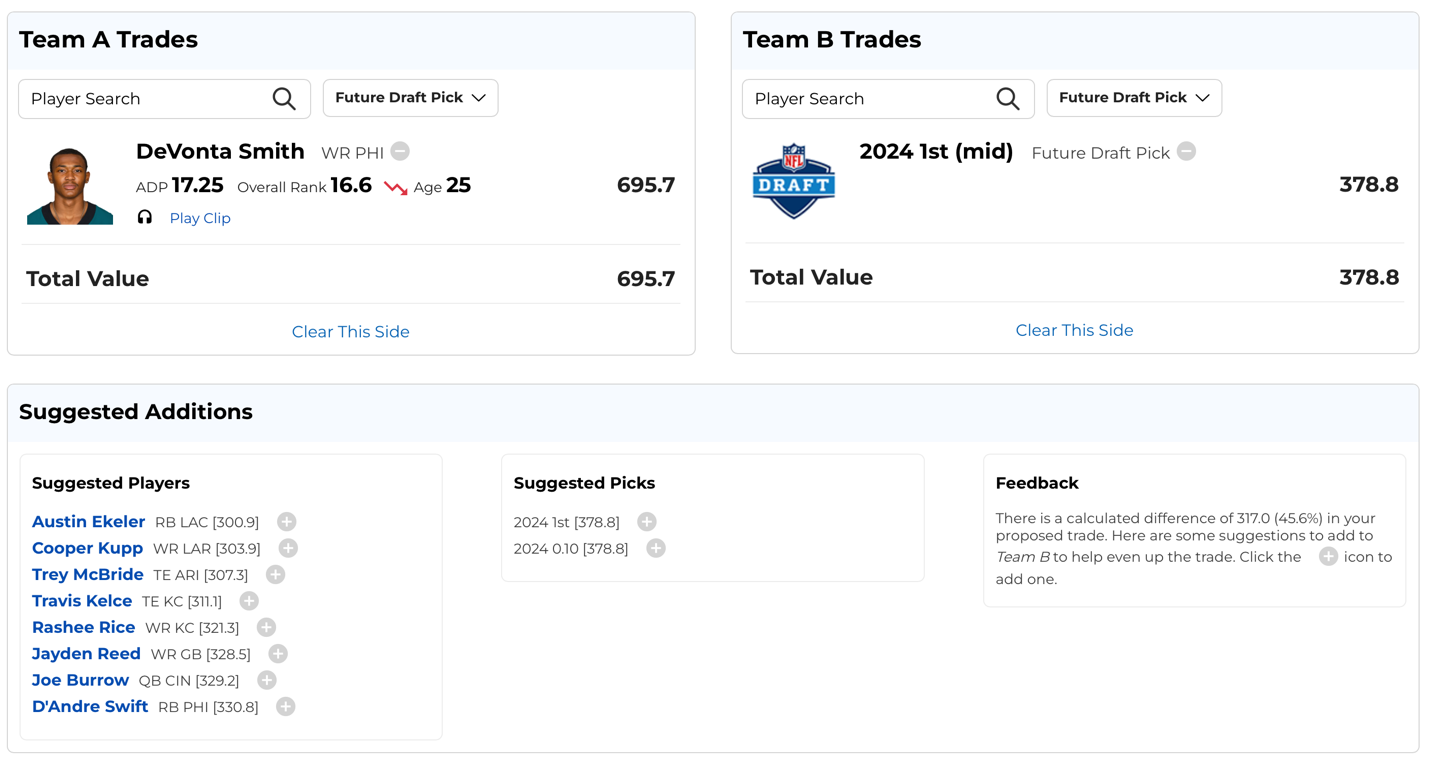
Rashee Rice would definitely get the job done for me here. Jayden Reed is close, as is Trey McBride. Short of this, you’re likely looking at a future first-round pick.
To be clear, this again is a macro view. You and your trade partner may not have these types of assets available, or the positions of interest might not fit the same. There will always be an aspect of personalization with every bit of advice, but hopefully this gets the ball rolling.
Hey Eric, similar to Cushy, I have a question about drafting. In my SF dynasty, I own the 1.05 and 1.08. Should I consider trading up to get a guy like Nabers inside the top 3-4? I’m coming off a chip with Josh Allen and Dak. I don’t think a QB is on my radar, thanks
— Burner #69 (@shlaMoney) January 9, 2024
Given the top-end talent at quarterback this year, the superflex format is a game-changer. Suddenly, pick 1.05 seems likely to yield Odunze, with quarterbacks Caleb Williams and Drake May presumably joining Harrison in coming off the board early, and even Jayden Daniels is hanging around as a dark horse. Given this, a trade-up may not be as costly as some of the moves detailed in the earlier part of this topic, as you may only need to go up a single slot.
Given the possibility of the selections breaking your way, I wouldn’t be in a major rush to get a deal done now. Instead, it might behoove you to wait until your draft is underway – it’s true that a pick is at its costliest when it’s on the clock, but there is a legitimate nonzero chance that the player you’re targeting (Nabers) could conceivably be available at your current pick 1.05 (he and Daniels are back to back with average ratings of 4.40 and 4.60, respectively, according to our rookie superflex rankings). No sense in spending draft capital you don’t have to, right?
If it doesn’t work out, I’d try to do something like sending your picks 1.05 and 1.08 for your trade partner’s 1.04 (or 1.03) and a future second-round pick. While again noting it’s not a bespoke fit, this is within the realm of reason, with the team giving up the best asset receiving slightly more value.

The last thing I’ll say relates to your final statement regarding your quarterbacks. I primarily play in superflex league formats myself, so I understood both the feelings of:
- Being content with the signal callers you’re currently rostering; and
- Understanding that you can still never have too many of them!
For me, one of my contenders was relying on Joe Burrow and Kirk Cousins. I was able to band-aid over the loss of the latter, but when the former joined him I was scrambling. It’s true you’re unlikely to ever roster four high-end quarterbacks in such a setting given the positional scarcity coupled with trade cost, but to me that almost places more of an emphasis on the rookie draft. Sure, first-round picks can be expensive, but even the best assets have room to grow. Just look at CJ Stroud’s rookie year – while noting this ADP is based off of data in a 1QB format, he’s jumped nearly 100 spots since September. All of a sudden spending a single first-round pick doesn’t sound too terrible!
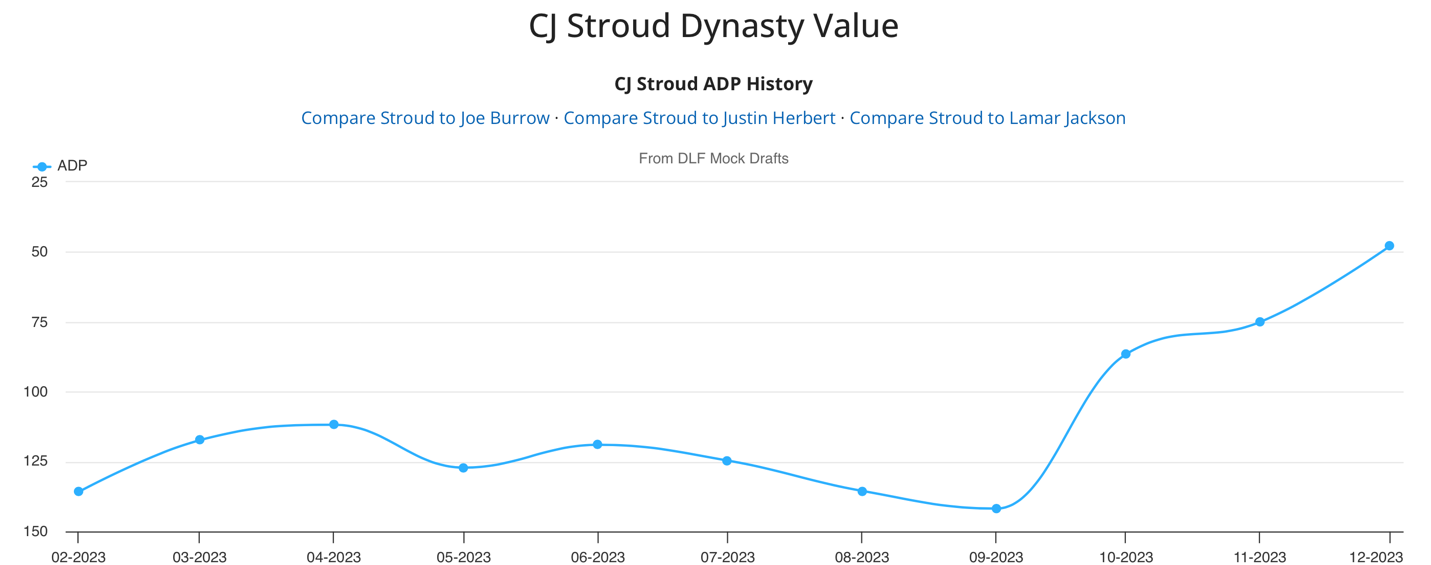
It’s also true that despite there being 32 NFL teams, there are not 32 great quarterbacks. This, to me, again places heightened importance on shooting your shot when possible. The duo of Josh Allen and Dak Prescott is spectacular, but the next man up is only one play away – you won your league so clearly what you’re doing is working, but perhaps this offers up another potential route forward!
- Dynasty Fantasy Football Mailbag: Justin Jefferson Or A Bundle Of Draft Picks? - April 23, 2024
- Dynasty Fantasy Football Mailbag: Is Kendre Miller Valued Unfairly? - April 17, 2024
- Forgotten Dynasty Veterans: Bottom Tier - April 9, 2024


































































